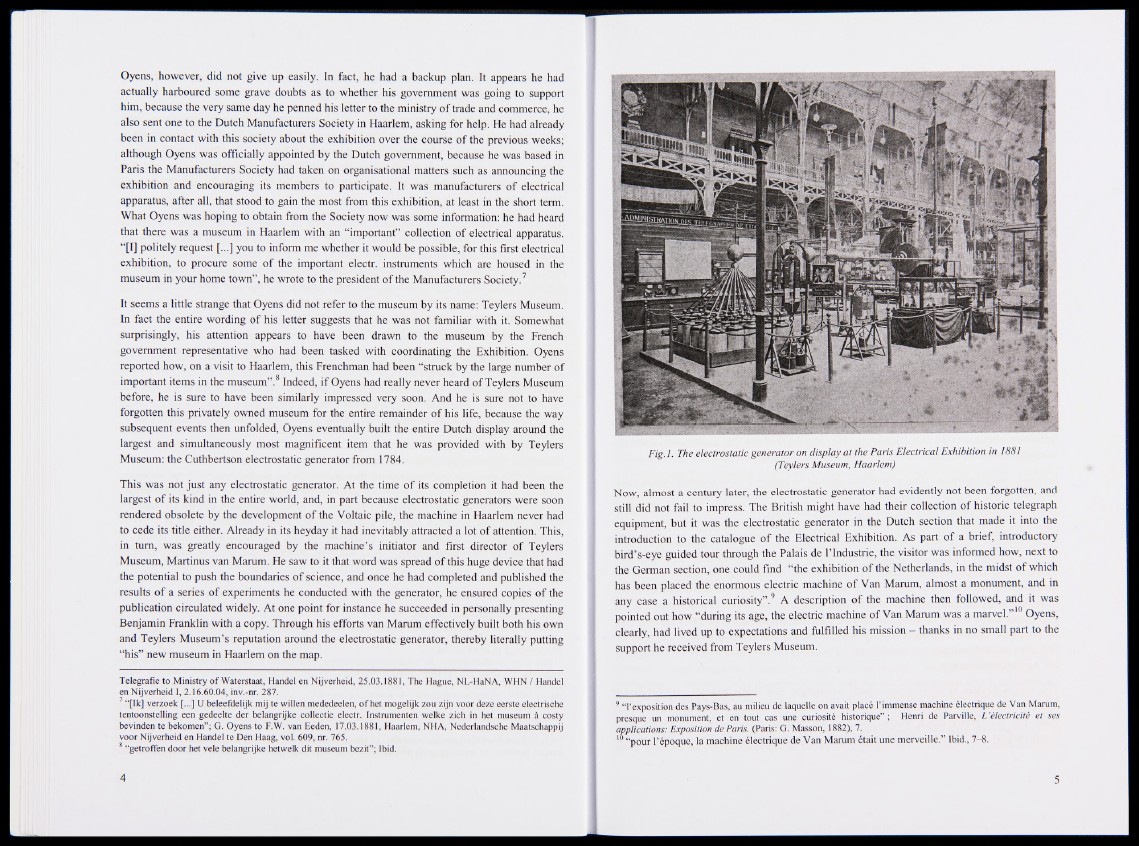
Oyens, however, did not give up easily. In fact, he had a backup plan. It appears he had
actually harboured some grave doubts as to whether his government was going to support
him, because the very same day he penned his letter to the ministry of trade and commerce, he
also sent one to the Dutch Manufacturers Society in Haarlem, asking for help. He had already
been in contact with this society about the exhibition over the course of the previous weeks;
although Oyens was officially appointed by the Dutch government, because he was based in
Paris the Manufacturers Society had taken on organisational matters such as announcing the
exhibition and encouraging its members to participate. It was manufacturers of electrical
apparatus, after all, that stood to gain the most from this exhibition, at least in the short term.
What Oyens was hoping to obtain from the Society now was some information: he had heard
that there was a museum in Haarlem with an “important” collection of electrical apparatus.
“[I] politely request [...] you to inform me whether it would be possible, for this first electrical
exhibition, to procure some of the important electr. instruments which are housed in the
museum in your home town”, he wrote to the president of the Manufacturers Society.7
It seems a little strange that Oyens did not refer to the museum by its name: Teylers Museum.
In fact the entire wording of his letter suggests that he was not familiar with it. Somewhat
surprisingly, his attention appears to have been drawn to the museum by the French
government representative who had been tasked with coordinating the Exhibition. Oyens
reported how, on a visit to Haarlem, this Frenchman had been “struck by the large number of
important items in the museum”.8 Indeed, if Oyens had really never heard of Teylers Museum
before, he is sure to have been similarly impressed very soon. And he is sure not to have
forgotten this privately owned museum for the entire remainder of his life, because the way
subsequent events then unfolded, Oyens eventually built the entire Dutch display around the
largest and simultaneously most magnificent item that he was provided with by Teylers
Museum: the Cuthbertson electrostatic generator from 1784.
This was not just any electrostatic generator. At the time of its completion it had been the
largest of its kind in the entire world, and, in part because electrostatic generators were soon
rendered obsolete by the development of the Voltaic pile, the machine in Haarlem never had
to cede its title either. Already in its heyday it had inevitably attracted a lot of attention. This,
in turn, was greatly encouraged by the machine’s initiator and first director of Teylers
Museum, Martinus van Marum. He saw to it that word was spread of this huge device that had
the potential to push the boundaries of science, and once he had completed and published the
results of a series of experiments he conducted with the generator, he ensured copies of the
publication circulated widely. At one point for instance he succeeded in personally presenting
Benjamin Franklin with a copy. Through his efforts van Marum effectively built both his own
and Teylers Museum’s reputation around the electrostatic generator, thereby literally putting
“his” new museum in Haarlem on the map.
Telegrafíe to Ministry o f Waterstaat, Handel en Nijverheid, 25.03.1881, The Hague, NL-HaNA, WHN / Handel
en Nijverheid I, 2.16.60.04, inv.-nr. 287.
“[Ik] verzoek [...] U beleefdelijk mij te willen mededeelen, o f het mogelijk zou zijn voor deze eerste electrische
tentoonstelling een gedeelte der belangrijke collectie electr. Instrumenten welke zich in het museum á costy
bevinden te bekomen”; G. Oyens to F.W. van Eeden, 17.03.1881, Haarlem, NHA, Nederlandsche Maatschappij
voor Nijverheid en Handel te Den Haag, vol. 609, nr. 765.
8 “getroffen door het vele belangrijke hetwelk dit museum bezit”; Ibid.
Fig. I. The electrostatic gen era to r on display a t the Paris E lectrical Exhibition in 1881
(Teylers M useum, Haarlem)
Now, almost a century later, the electrostatic generator had evidently not been forgotten, and
still did not fail to impress. The British might have had their collection of historic telegraph
equipment, but it was the electrostatic generator in the Dutch section that made it into the
introduction to the catalogue of the Electrical Exhibition. As part of a brief, introductory
bird’s-eye guided tour through the Palais de l’lndustrie, the visitor was informed how, next to
the German section, one could find “the exhibition of the Netherlands, in the midst of which
has been placed the enormous electric machine of Van Marum, almost a monument, and in
any case a historical curiosity”.9 A description of the machine then followed, and it was
pointed out how “during its age, the electric machine of Van Marum was a marvel.” Oyens,
clearly, had lived up to expectations and fulfilled his mission - thanks in no small part to the
support he received from Teylers Museum.
9 “l’exposition des Pays-Bas, au milieu de laquelle on avait placé l’immense machine électrique de Van Marum,
presque un monument, et en tout cas une curiosité historique” ; Henri de Parville, L ’électricité et ses
applications: Exposition de Paris. (Paris: G. Masson, 1882), 7.
10 “pour l’époque, la machine électrique de Van Marum était une merveille.” Ibid., 7-8.